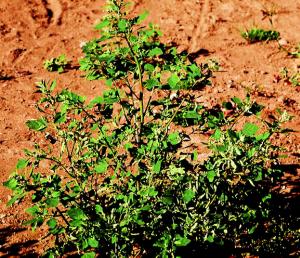CONTENTS
Registered Herbicides
[Return to weed
Identification]
[Return to Weed
Management]
[Home] |
|

General Description:
- upright annual (1-4 feet) with many branches.
- mature leaves are alternate with a wavy margin on
lower leaves.
- soft gray coating on yong leaves and underside of
mature leaves.
- smal, sessile, inconspicuous gray-green flowers in
dense clusters in leaf axils and branch tips.
- rapid grower with high water use, very competitive.
- short taproot is branched.
- acts as a host for beet leafhopper which transmits
curly top virus to beets.
- edible, young growth is often included in salad
greens.
- Seedling: Cotyledons are linear, long, narrow,
and are dark red on the underside. The first true leaves tend to be ovate to triangular,
and are arranged altrenately.
- Juvenile: Leaves are alternate, coarsely
toothed, and ovate in shape. The leaves have petioles and the underside is covered with
white mealy particles.
- Mature: Lambsquarters has an erect growth form
with alternate, coarsely toothed, ovate leaves. Grows 1 to 3 feet tall. The undersides of
the leaves are covered with white mealy particles. Stems are grooved and have many
branches.
- Flowers: Flowers are greenish and indistinct.
The flowers occur in clusters in the leaf axils.
Life cycle: annual
- reproduces by seed, one plant may produce over a 1000
seeds.
- seeds may persist in the soil profile for many years.
- seedlings emerge in spring, early summer, and early
fall.
- flowers on spikes appear July - September.
Habitat/ Crops associated with:
- does well on both acidic and alkaline soils.
- found in cultivated and waste areas thoughout the U.S.
- common in most horticultural crops.
- found in sugarbeets, potatoes, mint, wheat, alfalfa,
dry bean.
Herbicide Control Notes:
- Goal often not adequate, and higher rates might cause
crop injury. Widespread resistance to Sinbar. Usually emerges too late for effective
control with Gramoxone.
|